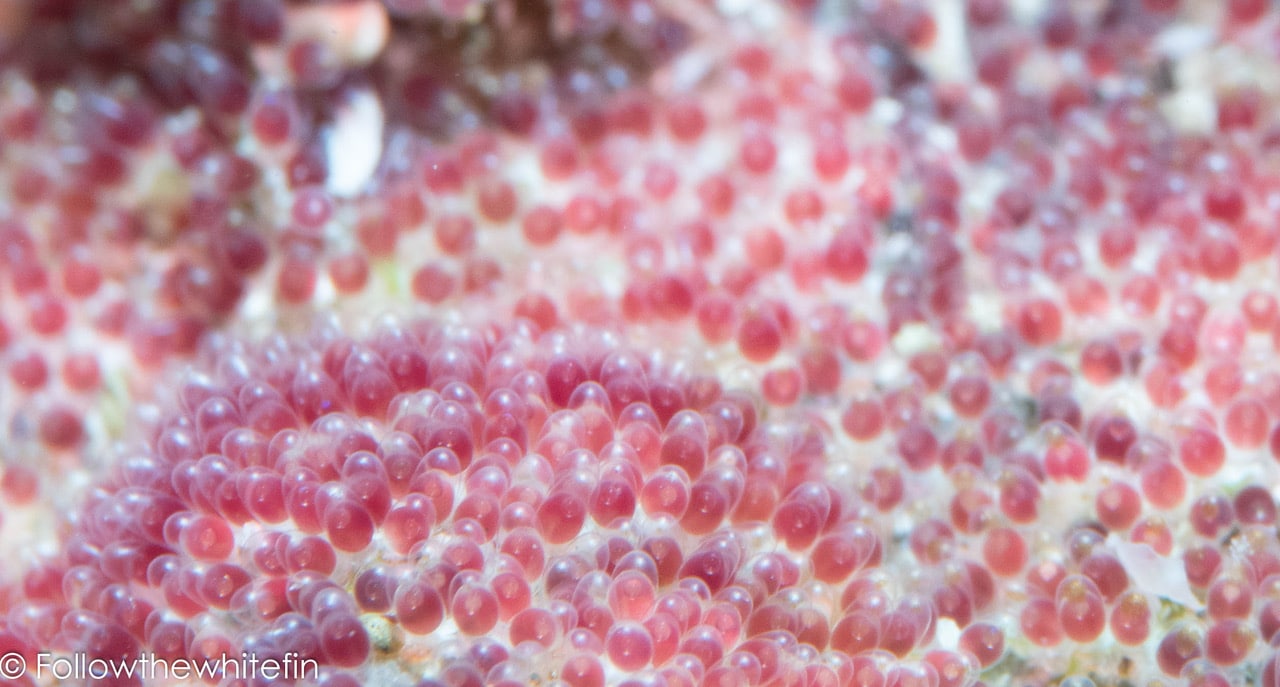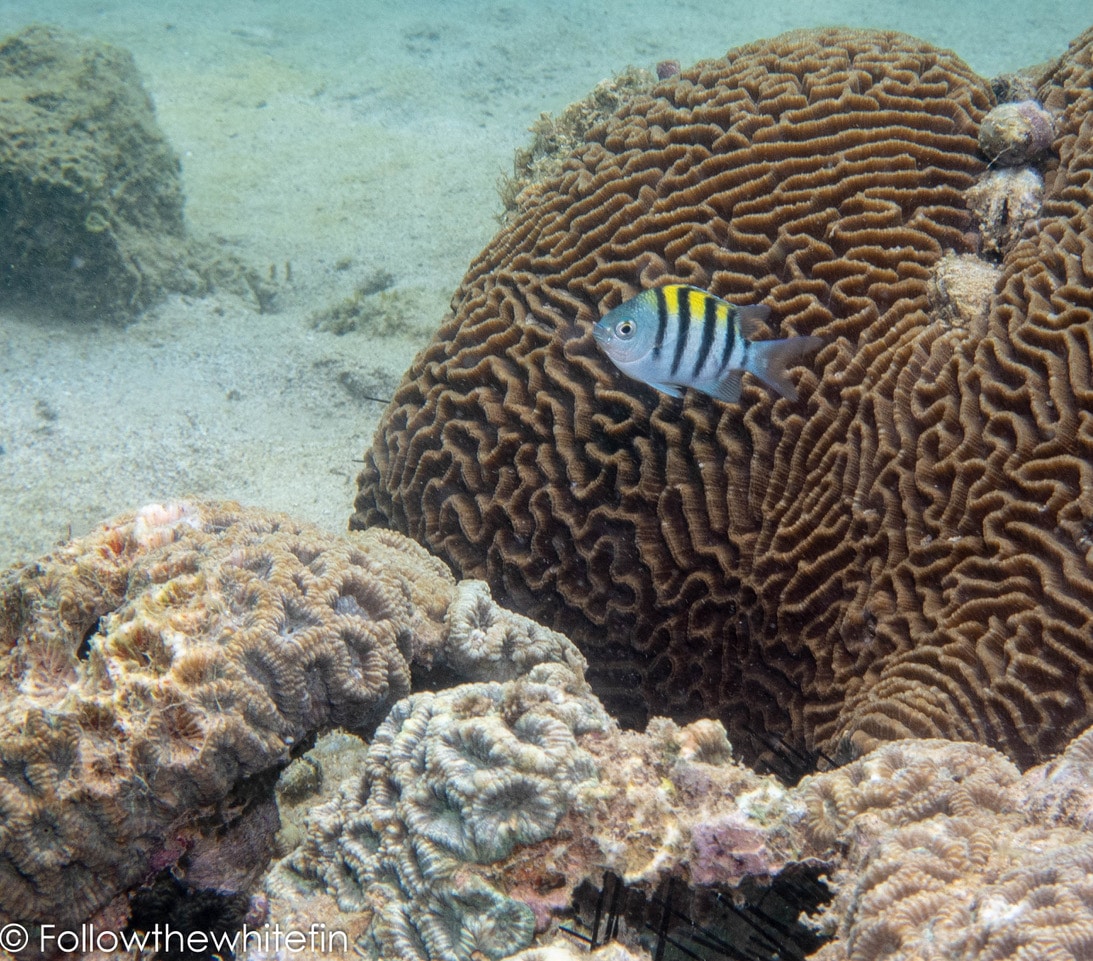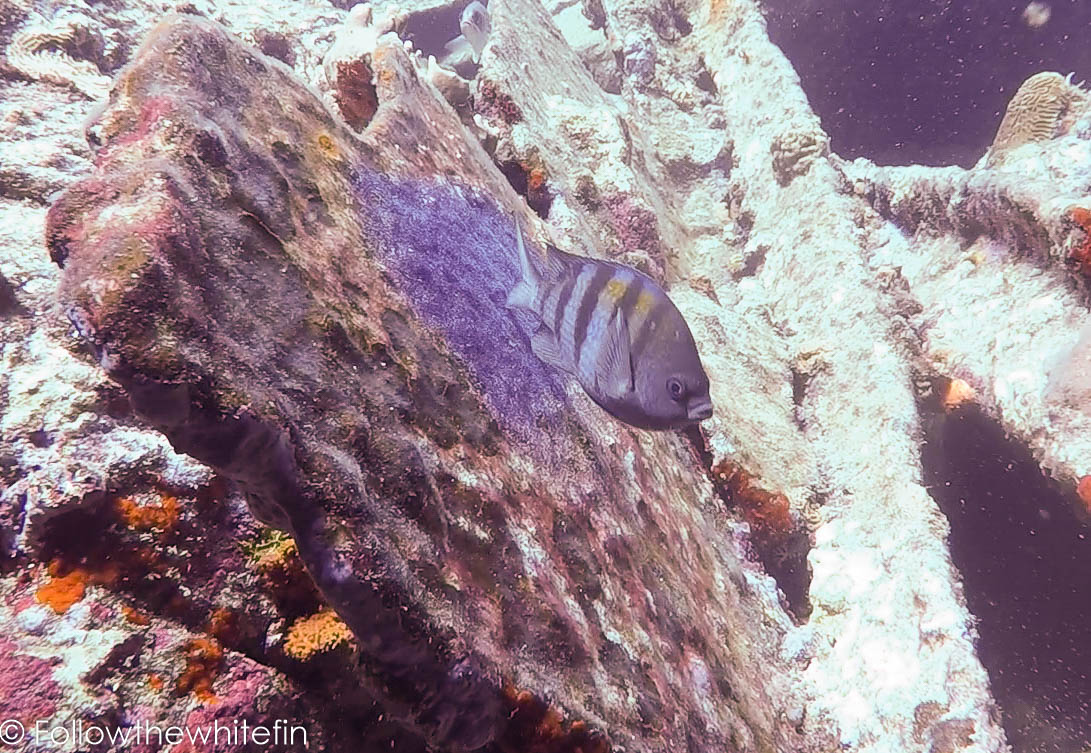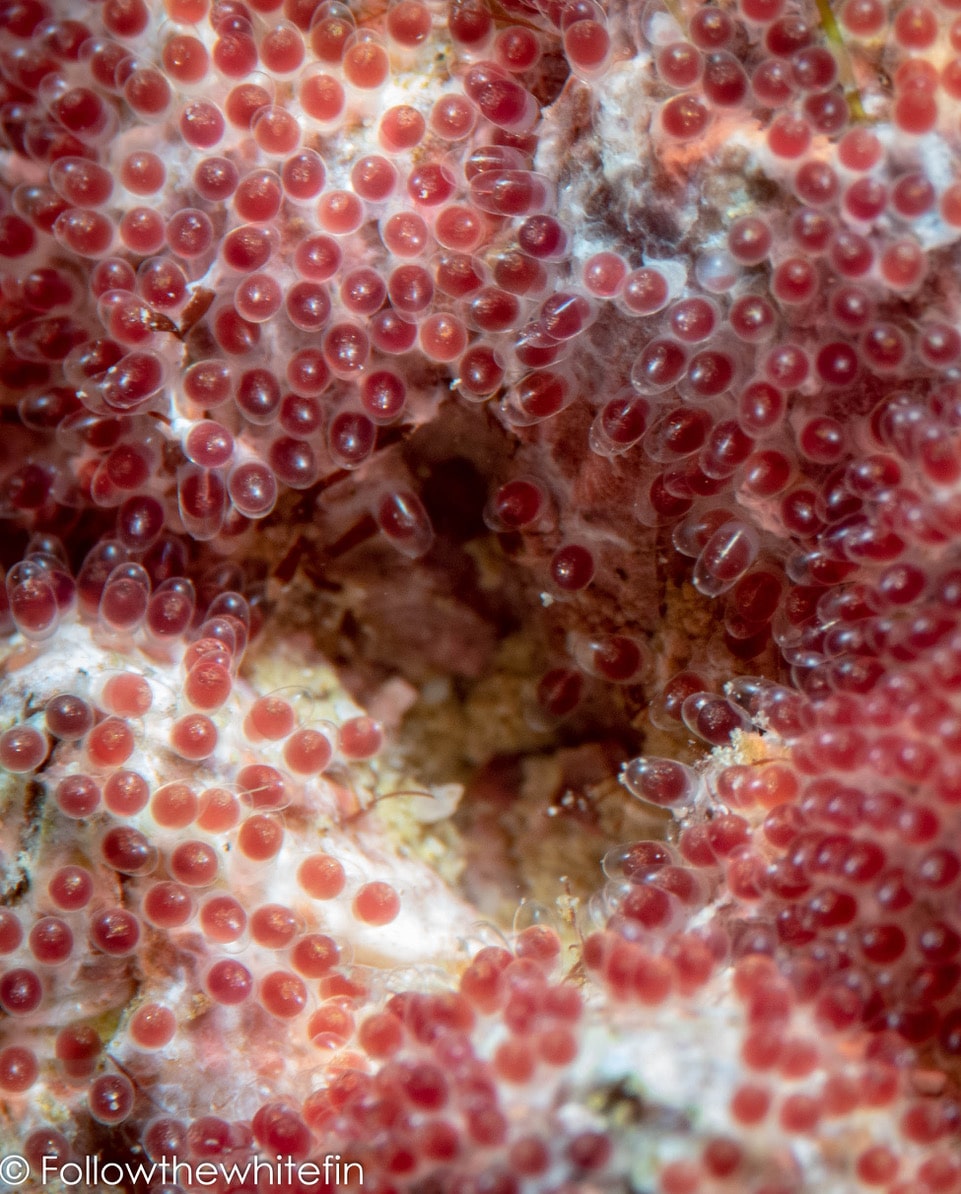Marine Life & Conservation
The Sergeant Major Fish: Underdog to Super-Dad

You’re on a dive, minding your own business when suddenly, your mask is being bombarded by a frantic and extremely angry creature. In shock you reverse, exiting the firing line when you realise that the monster in question is none other than the Sergeant Major Fish.
If your biggest fear in the ocean is the ‘dreaded shark’, think again, it’s the Sergeant Major you really have to worry about!! In disbelief you take a second glance and notice that the creatures you once thought were small and peaceful are all behaving in this manner to anything crossing or invading their path.
Why do they behave like this? And why have you never noticed this before?
Background Check
Abudefduf is from the Arabic; abu “the one with”, def “side”, and duf “prominent”. Its name, referring to the vertical black bars on its side, roughly translating to “the one with prominent sides”. This is also where its gets its common name “Sergeant Major,” as the stripes resemble the bars on a military uniform. Despite the general common name Sergeant Major there are up to 20 species of this damselfish, part of the family Pomacentridae, that you can be found worldwide. Generally, their bodies are deep, oval and compressed with a continuous dorsal fin and a forked caudal fin, but each species varies in size and the number of dorsal fins, dorsal soft rays, anal spines and anal soft rays.
Meet the Locals
Here in the UAE we have the Indo-pacific Sergeant Abudefduf vaigiensis. Widely distributed throughout the Indo-Pacific: Red Sea, Indian Ocean to eastern Africa, north to southern Japan, and south to Australia. In 1991, it was even discovered in the Hawaiian Islands, possibly floating marine debris such as abandoned fishing nets, where it now coexists with the Hawaiian Sergeant Abudefduf abdominalis. They form large aggregations while feeding during the day and play hide and seek by themselves at night on coral reefs, tidal pools and rocky reefs at depths between 1 to 15 m. The Indo-pacific Sergeant can grow up to 20 centimetres long, feeding on zooplankton, benthic algae and small invertebrates.
The Interesting Part!
So now you have the Sergeant Major’s background check. Here’s the fascinating part!
Between March and August, the Sergeant Majors congregate in large numbers to reproduce. To start the process, the males prepare temporary nesting sites by coating patches of rocks, shipwrecks and corals with an adhesive substrate. The females then wander around looking for that special partner to mate with. When a female is near, the male will try to attract the female by preforming a unique and intriguing dance which involves moving up and down erratically, like the local dance club. If she’s digging his moves she will deposit up to 20,000 eggs. Once the eggs have dispersed, they attach themselves to the substrate the males prepared and will then be fertilized.
After all the fun, the females eventually take off leaving the males with all the responsibility of protecting his little patch. The male is extremely attentive by continuously aerating his eggs stopping fungus build up. He will also turn a darker bluish colour which most likely acts as a warning colour to predators or even possible camouflage. Any fish that comes too close are aggressively chased away and divers are left in bewilderment.
The eggs start as solid red ovals around 0.5-0.9mm. Once they are fertilised they start to turn a green colour with a deep red yolk leaving the surfaces as a patchwork. After 4-5 days the eggs will hatch an hour after sunset. If you are able to see the hatching, it can be amazing to watching as they wiggle out from the substrate and break free. Once hatched they are around 2.4mm in size and set off to tackle the big blue ocean.
I have been very privileged over the last few weeks to witness parts of this process and they are amazing to watch. The reef has literally been covered in patches of varying shades of red and green. The determination of the male Sergeant Major whilst hilarious to watch is also impressing for such a small creature to display. With my new camera I was able to catch some of these processes, but my next goal is to capture the courtship ritual and hatching (I may need a bigger camera though).
Next time you are out diving, make sure you don’t overlook the little guys, and look out for the patchwork of the ocean created by the Sergeant Major Fish.
Find out more about Kayleigh at www.followthewhitefin.com
Blogs
The Ocean Cleanup Breaks 10,000,000 KG Barrier

The Ocean Cleanup, the global non-profit project, has removed a verified all-time total of ten million kilograms (22 million lbs.) of trash from oceans and rivers around the world – approximately the same weight as the Eiffel Tower.
To complete its mission of ridding the oceans of plastic, The Ocean Cleanup uses a dual strategy: cleaning up the Great Pacific Garbage Patch (GPGP) to remove the plastic already afloat in the oceans, while stopping the flow of plastic from the world’s most polluting rivers.
Through cleaning operations in the GPGP and in rivers in eight countries, the cumulative total of trash removed has now surpassed ten million kilograms. This milestone demonstrates the acceleration of The Ocean Cleanup’s impact, while underlining the astonishing scale of the plastic pollution problem and the need for continued support and action.
While encouraging for the mission, this milestone is only a staging point: millions more tons of plastic still pollute our oceans and The Ocean Cleanup intends to continue learning, improving and innovating to solve this global catastrophe.
This announcement comes as governments from around the world meet to continue negotiations to develop a new legally binding instrument to end plastic pollution at INC4 in Ottawa, Canada. Representatives of The Ocean Cleanup will be in attendance and the organization will be urging decision-makers to collaborate towards a comprehensive and ambitious global treaty which addresses plastic at all stages of its life cycle and in all marine environments worldwide, including in areas beyond national jurisdiction.
It is encouraging to see that the need for remediation is reflected in the various options for potential treaty provisions. It is essential that the final treaty contains clear targets for the remediation of legacy plastic pollution, and reduction of riverine plastic emissions.
Tackling plastic pollution requires innovative and impactful solutions. The treaty should therefore incentivize the innovation ecosystem by fostering innovations that make maximal use of data, technology and scientific knowledge – such as those designed and deployed by The Ocean Cleanup.
‘After many tough years of trial and error, it’s amazing to see our work is starting to pay off – and I am proud of the team who has brought us to this point.’ said Boyan Slat, Founder and CEO of The Ocean Cleanup. ‘While we still have a long way to go, our recent successes fill us with renewed confidence that the oceans can be cleaned.’
The Ocean Cleanup was founded in 2013 and captured its first plastic in 2019, with the first confirmed catch in the GPGP coming soon after the deployment of Interceptor 001 in Jakarta, Indonesia. After surpassing one million kilograms of trash removed in early 2022, the non-profit project has since progressed to the third iteration of its GPGP cleaning solution, known as System 03, and a network of Interceptors currently covering rivers in eight countries, with more deployments set for 2024.
About The Ocean Cleanup
The Ocean Cleanup is an international non-profit organization that develops and scales technologies to rid the world’s oceans of plastic. They aim to achieve this goal through a dual strategy: stemming the inflow via rivers and cleaning up the legacy plastic that has already accumulated in the ocean. For the latter, The Ocean Cleanup develops large-scale systems to efficiently concentrate the plastic for periodic removal. This plastic is tracked and traced through DNV’s chain of custody model to certify claims of origin when recycling it into new products. To curb the tide via rivers, The Ocean Cleanup has developed Interceptor™ solutions to halt and extract riverine plastic before it reaches the ocean. Founded in 2013 by Boyan Slat, The Ocean Cleanup now employs a broadly multi-disciplined team of approximately 140. The foundation is headquartered in Rotterdam, the Netherlands.
For more information, visit: theoceancleanup.com and follow @theoceancleanup on social media.
Marine Life & Conservation
Steve Backshall to headline Shark Trust’s flagship event: For the Love of Sharks

Join a host of amazing, shark loving, speakers including Steve Backshall and the Shark Trust team for an evening celebrating shark conservation at the Royal Geographical Society in London this November.
Date: 29th November 2024
Time: 6-10pm
Location: Royal Geographical Society, London
Tickets: https://www.sharktrust.org/Event/flos24
The event will be a celebration of all things shark. Those lucky enough to get hold of tickets will hear from engaging guest speakers with a passion for sharks.
The line-up includes (*subject to change if unforeseen circumstances arise)
Steve Backshall: One of television’s busiest presenters, BAFTA award-winning wildlife expert Steve has been passionate about the wild world ever since he was young.
Steve’s impressive TV career has taken him all around the world, investigating a wide array of species and environments. Steve has filmed over 100 hours of children’s wildlife programmes with the BAFTA award winning Deadly 60 franchise and recently, with Sky Nature, for his new series ‘Whale with Steve Backshall’. He has been a patron for the Shark Trust for 10 years.
Simon Rogerson: is a photojournalist specialising in natural history, diving and the sea.
He is editor of SCUBA magazine, the official journal of the British Sub-Aqua Club. Simon started his career as a crime reporter but gravitated towards his ‘less depressing’ interest in underwater exploration, joining the staff of DIVE magazine in 1999. In 2005 he was named ‘Editor of the Year’ in the PPA’s Independent Publishing Awards. Simon also works as a freelance writer, contributing frequently to the Sunday Times and Telegraph, in addition to BBC Wildlife, Esquire, and a host of international diving magazines. He is the author of a book, Dive Red Sea, published by Ultimate Sports. Now based in Berkshire, Simon has been a Patron of the Shark Trust for 20 years.
More speakers to be announced soon. Head to the Shark Trust website to learn more.
The evening will also allow guests the final chance to see the Oceanic 31, shark art exhibition. Some of the artwork will be auctioned/raffled at the event, while the rest will be auctioned online to raise money for the Shark Trust Oceanic Programme.
For the Love of Sharks is an evening with something for everyone who is interested and fascinated by sharks. Join the Shark Trust, their Patrons, Trustees and Staff, along with a host of supporters for this celebration of shark conservation.
For more information or to buy a ticket: https://www.sharktrust.org/Event/flos24
-

 News3 months ago
News3 months agoCapturing Critters in Lembeh Underwater Photography Workshop 2024: Event Roundup
-

 Marine Life & Conservation Blogs3 months ago
Marine Life & Conservation Blogs3 months agoCreature Feature: Swell Sharks
-

 Blogs2 months ago
Blogs2 months agoMurex Resorts: Passport to Paradise!
-

 Gear Reviews3 weeks ago
Gear Reviews3 weeks agoGEAR REVIEW – Revolutionising Diving Comfort: The Sharkskin T2 Chillproof Suit
-

 Blogs3 months ago
Blogs3 months agoDiver Discovering Whale Skeletons Beneath Ice Judged World’s Best Underwater Photograph
-

 News3 months ago
News3 months agoPADI Teams Up with Wellness Brand Neuro to Drive Ocean Change and Create a Blue State of Mind
-

 Gear Reviews3 months ago
Gear Reviews3 months agoGear Review: Oceanic+ Dive Housing for iPhone
-

 News3 months ago
News3 months agoWorld’s Best Underwater Photographers Unveil Breathtaking Images at World Shootout 2023








